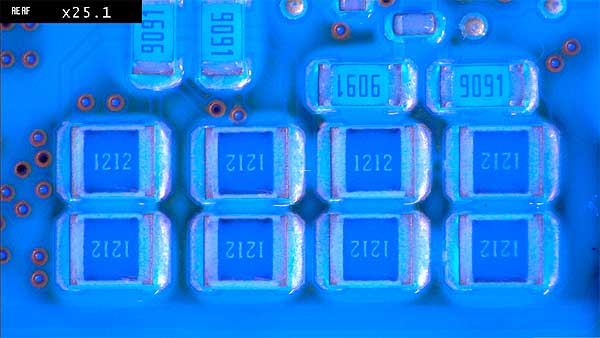Due to increasing miniaturization and packing density on assemblies Plasmatreat GmbH has recorded a higher demand for Openair-Plasma in combination with conformal coatings in electronic manufacturing. Plasma application as pre-treatment to conformal coating of assemblies and components ensures that the process window for conformal coating is widened, guaranteeing long-lasting connections and functionality.
“If we look at the latest developments in electronics of the recent years, we can assume that miniaturization and high packing density will continue to increase as will the functionality of electronic assemblies. Furthermore, electronics are used in increasingly demanding applications, with the goal of error-free and reliable operation. Especially eMobility and the autonomous use of different vehicles will further strengthen these goals. The need to protect electronics from environmental influences will therefore continue unabated,” states Nico Coenen, Business Development Manager Electronics Market at Plasmatreat GmbH.
As a result, conformal coating processes are being used more and more to protect components from a wide variety of influences. However, Coenen points out that this development is not without issues: “We know that conformal coating has many variables that can affect the final quality and can lead to bubble formation, orange peel formation, uneven coatings and delamination. There are many reasons for these defects, for example the incompatibility of materials, the soldering profiles used or the quality of printed circuit boards and components. As an electronics manufacturer, I can tackle the reasons mentioned here on my own, but there are also situations where further actions need to be considered. This is where our Openair-Plasma technology can help,” says Coenen.
Plasmatreat’s Openair-Plasma technology has been used for many years for surface treatment in the electronics production. Plasma technology is based on a simple physical principle. Matter changes its state when energy is supplied to it: solids become liquid, and liquids become gaseous. If even more energy is supplied to a gas, it is ionized and goes into the energy-rich plasma state, the fourth state of matter. In 1995 Plasmatreat was the first to introduce a plasma jet that could work in an atmospheric condition. In electronic production, surfaces are processed this way to improve for example the adhesion of conformal coating materials. Plasmatreat has proven the reliability of this process repeatedly. Coenen remembers the example of a German company in the aerospace industry.
“For years, the company produced assemblies with the same components and the same processes, until a quality inspection revealed that the protective coating material did not adhere permanently to certain components,” recalls Coenen. The reason for this was a new mold release agent used by the component manufacturer, of which the customer had not been informed. A component exchange was not possible, so that other solutions were called for. A solvent-based primer was out of the question due to cost and environmental reasons, and laser pre-treatment was ruled out on the grounds that the uneven surface would have made the coupling efficiency unpredictable. CO2 snow jets did not produce the desired results. Ultimately, the decision was made to use Openair-Plasma for surface treatment to create a stable, long-lasting bond between the component material and the coating material. Subsequent burn-in tests confirmed the adhesion quality of the conformal coating material.
Companies such as Rohde & Schwarz, but also suppliers to the automotive industry, have been using plasma technology to safeguard their conformal coating processes for years. Each new application, however, is customer-specific because the parameters that lead to the failure of the conformal coating process are very versatile. “Every year we conduct a lot of evaluations and case studies with customers and interested parties,” says Coenen. The most diverse coating materials, coating systems and test procedures are used, depending on the customer’s area of application. “As a rule, the fundamental question is what influence plasma has on the coating compounds and whether they are still present, for example after a thermal shock test,” Coenen explains the procedure. In a study, for example, four different coating materials were applied to assembled customer circuit boards. Some of these printed circuit boards were pre-treated with Openair-Plasma before the coating process, cured after application and then subjected to loads ranging from -40°C to 130°C in a series of thermal shock tests. These loads were repeated 250 times every 30 minutes. “In this case, we were able to prove that the bond between the printed circuit board and the coating material was much more stable and reliable with plasma-treated printed circuit boards than with untreated samples. The coating material enclosed the components with a homogeneous surface without bubbles, cavities or delaminations,” recalls Coenen.
Plasmatreat also contradicted the assumption that atmospheric plasma would destroy components on printed circuit boards based on a customer study, in which all samples were fully functional after plasma treatment. “Of course, circuit boards are partially conductive, and it is also true that for a long time no atmospheric plasma process could be used to clean the circuit boards because there was a risk of short circuits associated with the destruction of layout and components. However, we developed the Openair-Plasma nozzle especially for such applications, which demonstrably works with a very low, harmless zero voltage input and thus does not influence components and layouts,” explains Christian Buske, Managing Director of Plasmatreat GmbH.
Plasmatreat will be presenting the Openair-Plasma technology at productronica 2019 in Hall B2, Booth 103.




